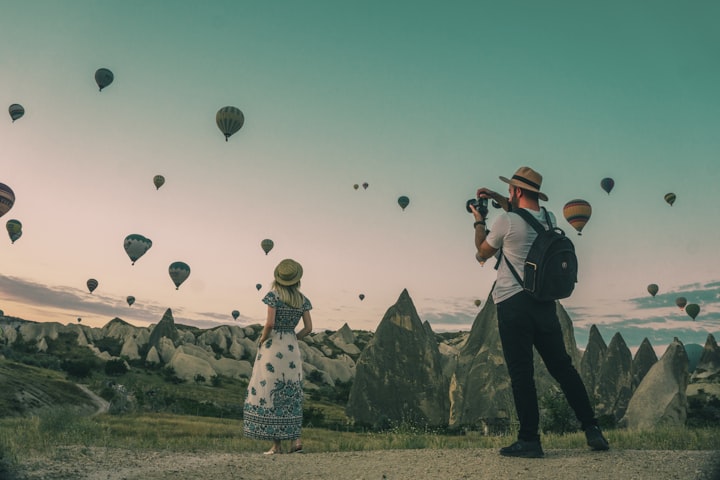5 Tips on How to Make Your Photography Amazing
But just master one of them at a time

Photography is a craft, a skill, and a vocation.
And like any other, there are abilities you need to master to do it well.
But you don’t have to learn everything at once. Take your time and learn one thing at a time and learn it well. Master each skill on this list, and you will be a photographer. Until then, you are just somebody that takes pictures.
1.Learn How to Focus
This tip may seem like the ultimate no-brainer, but learning how to focus isn’t as easy as you think. Cameras get smarter every year, and they are very good at obtaining a proper focus. But what is correct? How does the camera know what you want in focus? The simple answer is, it doesn’t.
You have to tell it.
One of the essential things you need to do to learn photography is to spend a lot of time with your camera’s manual. Read it. Reread it.
Take some pictures.
Read it again.
One area you need to, well, focus on, is focus. There are two aspects of this you need to study in the manual and put into practice. One is how to select and use the focus area. The other is how to select and use the focus points. These are similar concepts but different enough in control and execution that it is best to master them separately.
Focus area refers to how large or small an area you want the camera to consider to achieve focus. Do you want it to evaluate the entire frame, or just one tiny point, or somewhere in between? All cameras have this capability. Learn how and when to use each mode and how to switch between them.
Most of the time, I use one of the smallest two or three focus areas. I want to select exactly where the camera focuses before I press the shutter. Even with live view, it may appear the entire frame is in focus, when in fact, it is not. This is especially critical when shooting portraits. The eyes must be in sharp focus, even if nothing else is.
The focus point determines where in the frame the focus area is pointing. It may sound like I am saying the same thing, but let me explain. The focus area is how much of the frame is being used for focus. The focus point is where that area is pointing.
As a default, the focus area will start in the center of the frame. This makes sense because many photographers center the subject. But that’s not necessarily the best composition. If you are using the rule of thirds, the subject will be off to the side.
You can point the focus area a the subject and then recompose the shot, and a lot of people, including myself, often do it this way. But it is slightly more accurate to move the focus point inside the frame to point at the subject so that recomposing isn’t necessary. With macro photography, this is important since recomposing will shift the plane of focus and cause the subject to fall outside your depth of field.
2.Learn to Read the Histogram
With digital cameras, you are able to check your shot as soon as you take it. With mirrorless cameras, you can see what it will look like before you shoot. But in both cases, your camera has the option of showing a histogram. The histogram is a graph of the tones in your image from the darkest to the lightest.
The problem is that the human eye can see a lot more of this range of light, called the dynamic range, than the camera can. If your histogram is too far to the left, you will lose details in the shadows. Too far to the right, and you lose detail in the highlights.
Learning how to read the histogram is the best way to ensure your image is exposed the way you want it to be. You won’t always be able to tell just by looking at the LCD. And when you get home, it may be too late, although shooting raw will give you more latitude.
Practice reading the histogram on your computer when you process images. It’s a lot easier to see on the big screen. Once you have become accustomed to how it looks in relation to the dynamic range of your scene, learning to read it on the camera will be much easier.
3. Learn How to Use Different Modes
When you first start, you are probably using ‘green’ or full auto mode. And that’s fine. But eventually, you will begin to see the limitations of that mode and want to expand your knowledge. To do this, you need to learn the different methods of your camera.
Start with the creative modes. These are the ones that look like a face, mountain, or flower on your control dial. Learning these modes will help you be more creative, but will also give you a foundation of knowledge to move on to more artistic methods.
The next modes you want to tackle are aperture and shutter priority. These modes will give you more control over how your images turn out while keeping a safety net in place. Within certain boundaries, the camera will still try to get a proper exposure, even if you make a bad choice. These are the modes in which you will most likely spend the majority of your shooting. I spend most of my time shooting in aperture priority, unless I am using strobes or flash.
A lot of people will tell you that to be a professional photographer, you have to shoot in manual mode. This is bunk. There are times when you need to shoot in manual, but these are the exceptions. Most of the time, manual mode is more work than it needs to be, and aperture priority will give you the same results. But whether you need to use manual mode or not, you should learn how to use it. This will provide you with the knowledge to understand if and when you should use it.
4. Learn How to Use Exposure Compensation
Exposure compensation is a handy control that is often overlooked by even seasoned photographers. No matter which mode you are in except for full auto and full manual, you can use exposure compensation to alter the exposure without manually changing aperture, shutter speed, or ISO.
It is excellent for making small adjustments on the fly. Exposure compensation is especially useful in conjunction with the histogram.
The exact method to use exposure compensation differs between brands and models, so refer to your manual and practice this valuable skill in the field.
5. Learn Your Gear
You might think this one should come first. And it does to a certain extent. As stated above, you should read and re-read your manual and learn every aspect of your camera as you shoot and grow as a photographer.
What this tip is really about is for when you think you have mastered your gear. You have not. At some point, you are going to look at your images and be unhappy with them. You will then start to blame your gear. You will decide that if you only had (fill in the blank), your images will be better. This is simply not true. The problem isn’t your gear. The problem is you.
Understand what is wrong with the picture and figure out what you need to change to fix it. Not by buying better equipment, but by learning the gear you already have. Once you have truly mastered your gear, you will know when it’s time to move on. But know this. A master photographer can take a better image with their cellphone than a beginner can with the most expensive gear available.
Learning photography is a life-long pursuit. If you try to learn everything at once, you will become frustrated and fail. Please take one of these tips at a time and master them. That is the way to become a great photographer.
If you enjoyed this article, please click the Heart, and if you really liked it, consider dropping me a tip below. Thanks for reading.
About the Creator
Darryl Brooks
I am a writer with over 16 years of experience and hundreds of articles. I write about photography, productivity, life skills, money management and much more.






Comments
There are no comments for this story
Be the first to respond and start the conversation.